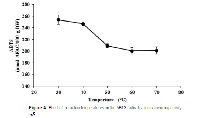Standardization of DPPH, ABTS and FRAP assays with six reference compounds for estimating antioxidant capacity of the tomato extracts using an ultrasound assisted extraction
Keywords:
Antioxidant capacity, Total phenolic, Ascorbic acid, Ultrasonication extractionAbstract
Comparative calibrating of the antioxidant power of standard compounds, including gallic acid, catechin, Trolox, α-tocopherol, ascorbic acid and BHT were assessed by DPPH, ABTS and FRAP assays to determine total antioxidant activity of ten varieties of tomato extracts using ultrasound assisted extraction. Similar trends in their scavenging activities were found, resulted in the following rank; gallic acid > catechin > trolox > α-tocopherol > ascorbic acid > BHT. Both lipophilic and hydrophilic parts of the extracts were given in these assays in association with using hexane and 50% (v/v) methanol as their efficient extraction solvents, respectively. Their averaged values of the ascorbic acid equivalent antioxidant capacities (AEAC, µmol ascorbic acid/100g DW) were relatively confined in the same ranges of 1341.8-1834.5, 1334.2-2194.8 and 930.7-1734.7 for DPPH, ABTS and FRAP, respectively. In addition, both contents of total phenolics and ascorbic acid known as major deals of antioxidants were also determined, indicating highly existing constituents of the natural antioxidants.
References
Arts MJTJ, Sebastiaan Dallinga J, Voss HP, Haenen GRMM, Bast A. Food Chem 2003;80:409-414.
Ballard TS, Mallikarjunan P, Zhou K, O’Keefe S. Food Chem 2010;120:1185-1192.
Biacs PA, Daood HG, Czinkotai B, Hajdu F, Kiss-Kutz N. Acta Hort 1998;220:433-438.
Burton GW, Joyce A, Ingold KU. Arch Biochem Biophys 1983;221:281-290.
Butcher JD, Crosby KM, Yoo KS, Patil B, Jifon JL, Rooney WL. Sci Horticult 2013; 159:72-79.
Cao G, Prior RL. Clin Chem 1998;44:1309-1315.
Cholbi MR, Paya M, Alcaraz MJ. Experientia 1991;47:195-199.
Havsteen B. Biochem Pharmacol 1983;32:1141-1148.
Heijnen CGM, Haenen GRMM, van Acker FAA, van der Vijgh WJF, Bast A. Toxicol Vitro 2001;15:3-6.
Hossaina MB, Bruntonb NP, Barry-Ryana C, Martin-Dianaa AB, Wilkinsonc M. Rasayan J Chem 2008;1:751-756.
Howard LR, Clark JR, Brownmiller C. J Sci Food Agr 2003;83:1238-1247.
Hudson BJF, Lewis JI. Food Chem 1983;10:47-55.
Karacabey E, Mazza G. Food Chem 2010;119:343348.
Katalinic V, Milos M, Kulisic T, Jukic M. Food Chem 2006;94:550-557.
Klein BP, Perry AK. J Food Sci 1982;47:941-945.
Kotíková Z, Lachman J, Hejtmánková A, Hejtmánková K. LWT-Food Sci Technol 2011;44:1703-1710.
Li H, Deng Z, Wu T, Liu R, Loewen S, Tsao R. Food Chem 2012;130:928-936.
Lindberg MH, Bertelsen G (1995) Spices as antioxidants. Trends Food Sci Tech 6: 271-277.
Martínez-Valverde I, Periago MJ, Provan G, Chesson A. J Sci Food Agr 2002;82:323-330.
Muselík J, García-Alonso M, Martín-López M, Žemlička M, Rivas-Gonzalo J. In J Mol Sci 2007;8:797-809.
Pernice R, Parisi M, Giordano I, Pentangelo A, Graziani G, Gallo M, Fogliano V, Ritieni A. Sci Horticult 2010;126:156-163.
Queiroz YS, Ishimoto EY, Bastos DHM, Sampaio GR, Torres EAFS. Food Chem 2009;115:371-374.
Rebiai A, Lanez T. J Fun Appl Sci 2012;4:26-35.
Retsky KL, Frei B. Biochim Biophys Acta Lipids Lipid Metabol 1995;1257:279-287.
Riahi A, Hdider C. Sci Horticult 2013;151:90-96.
Rosa LADL, Wiley I, Alvarez-Parrilla E, González-Aguilar GA (2010). Fruit and vegetable phytochemicals chemistry, nutritional value, and stability. Ames, Iowa: Wiley-Blackwell.
Sies H. Exp Physiol 1997;82:291-295.
Takahama U. Phytochem 1985;24:1443-1446.
Takeoka GR, Dao L, Flessa S, Gillespie DM, Jewell WT, Huebner B, Bertow D, Ebeler SE. J Agric Food Chem 2001;49:3713-3717.
Teow CC, Truong V-D, McFeeters RF, Thompson RL, Pecota KV, Yencho GC. Food Chem 2007;103:829-838.
Thaipong K, Boonprakob U, Crosby K, Cisneros-Zevallos L, Hawkins Byrne D. J Food Compos Anal 2006;19:669-675.
Toor RK, Savage GP. Food Res Int 2005;38:487-494.
Tsou T-C, Chen C-L, Liu T-Y, Yang J-L. Carcinogenesis 1996;17:103-108.
Vallverdú-Queralt A, Medina-Remón A, Casals-Ribes I, Lamuela-Raventos RM. Food Chem 2012;130:222 -227.
Wang H, Cao G, Prior RL. J Agric Food Chem 1996;44:701-705.
Yao D, Vlessidis AG, Evmiridis NP, Zhou Y, Xu S, Zhou H. Anal Chim Acta 2002;467:145-153.



